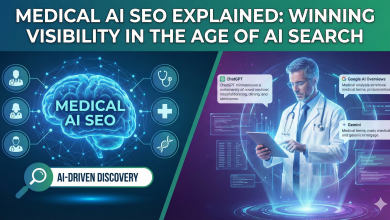
The holiday shopping season is always a high-stakes moment for brands, but this year, it’s entering uncharted territory. With Black Friday, Christmas and peak-season promotions just around the corner, brands are preparing for a consumer journey that looks very different from just a few years ago.
Recent research shows that one in three shoppers plan to use AI to assist with their holiday purchases this year, marking a major shift in how consumers discover, evaluate and buy products. This means it’s now crucial that brands are aware of how they can stay discoverable, trusted and chosen in a world where AI, not just humans, are making the decisions.
Optimising for AI-powered discovery
Winning the AI-powered holiday shopping rush starts with rethinking how your brand shows up in the moments that matter. Discovery is no longer driven through traditional search alone. Tools like ChatGPT and Google Gemini are now answering product queries directly, often without users even clicking through to a brand’s site.
This is already impacting organic traffic across brands; however, it also presents a major opportunity. Inclusion in AI-generated answers can deliver high-intent visibility without the cost of paid media, a valuable advantage in categories with historically high acquisition costs.
To capitalise on this, brands need to optimise their content for large language models (LLMs). Structured, factual content such as ingredient lists, sizing guides, product comparisons and FAQs performs best. AI rewards clarity, consistency and credibility rather than overly promotional content. Topic authority is also key. Brands that consistently publish expert content in a focused niche are more likely to be surfaced in AI responses.
Frameworks like a GEO (Generative Engine Optimisation) Scorecard can help brands measure and improve visibility in LLMs by tracking reach, rank and sentiment. As AI becomes a dominant discovery channel this holiday season, improving your GEO Score could be the difference between being seen or skipped.
Embracing Agentic AI
Beyond discovery, Agentic AI is transforming the entire customer lifecycle. But first, let’s explain what that is. Generative AI is about content creation and answering questions whereas Agentic AI is about autonomous action and task completion. While Generative AI provides the answers, Agentic AI is the technology that will act on those answers – interpreting a shopper’s intent and completing tasks like comparing prices across multiple sites or even making a purchase without human intervention.
The initial step is ensuring your data is accurate, consistent and structured across every channel. Audit your product feeds, descriptions and pricing to ensure they’re complete, consistent and up to date across every channel. AI agents rely on this information to make decisions, so incomplete or outdated product feeds can cost you visibility and sales.
Next, embed your brand voice and values into every piece of content. As AI agents take on more decision-making, your identity must still come through. Move away from purely promotional copy and create authoritative, value-driven content that position your brand as an expert. This is the content AI will reference when answering customer queries.
In addition, make sure tone, messaging and product representation are aligned with clear guidelines. Then, monitor how AI platforms display your brand to ensure consistency and accuracy. At the same time, strengthen human-validated signals such as authentic reviews, creator partnerships and trusted backlinks to reinforce credibility into the AI ecosystem.
Finally, think beyond the purchase. Use personalised support and proactive engagement to build loyalty and retention. By aligning structured data with your brand’s tone and values, you ensure that even when AI is doing the buying, your distinctive voice remains front and centre.
Personalisation at scale
AI also enables brands to deliver personalisation at scale. Consumers now expect experiences tailored to their needs, preferences and behaviours. They also want this delivered seamlessly across all channels. From homepage layouts to product recommendations, AI can adapt content in real-time based on user behaviour, location, purchase history and even intent signals so that shoppers can see the most relevant products, offers and messages.
It’s important to remember that personalisation is about maintaining consistency and control while delivering highly tailored experiences. The key to achieving this is by building a unified data foundation that feeds into AI systems across platforms, ensuring messaging, pricing and product availability remains aligned, no matter where the customer is browsing.
Equally important is the quality of your data. Regularly auditing and validating your data ensures accuracy and completeness, which directly shapes your personalisation strategy and prevents misaligned experiences.
AI also enables brands to test and optimise content continuously. By analysing what content resonates with different audiences, brands can refine their messaging and creative in real time, enhancing engagement and conversion without compromising brand integrity
The new rules of holiday shopping: Adapt or be overlooked
The AI-powered holiday season is here and it’s changing everything from how consumers discover products to how they make decisions and where they convert. Winning in this new environment means brands need to be prepared to optimise for AI discovery, align with Agentic AI and deliver personalisation at scale.
The brands that succeed won’t necessarily be the ones with the biggest budgets or best marketing campaigns. They’ll be those that understand how AI is reshaping the path to purchase and are ready to meet customers, wherever, and however, they choose to shop.



